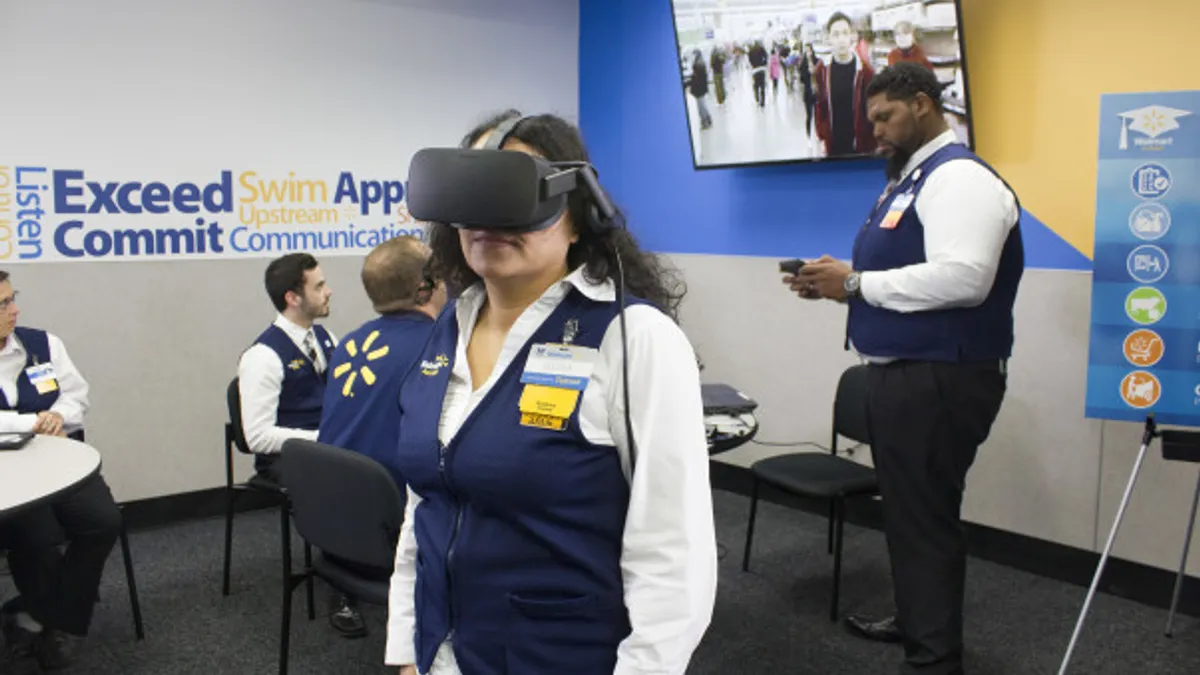Dive Brief:
- Wal-Mart has been testing virtual reality in 31 of its training facilities in recent months and plans to soon expand the program, a spokeswoman for Wal-Mart said in an email to Retail Dive.
- On a company blog, Wal-Mart said the technology could be used, among other things, to help prepare employees for busy store conditions, such as during the holiday season and to help associates learn how to execute tasks without disrupting the flow of shopping in stores.
- The retailer anticipates it will ultimately use VR to help train some 140,000 associates annually at its employee “academies,” which are expected to number 200 by the end of the year, the Wal-Mart spokeswoman noted.
Dive Insight:
Wal-Mart hopes that VR — from STRIVR, a VR technology company focused on human performance — can add nuance, visuality and memory retention to training programs. The addition of the technology to training aligns not only with retailers’ expanded interest in VR tech but also Wal-Mart’s increased investment in employees as it tries to maintain market share in a fiercely competitive retail world.
“Ultimately, everything associates do is geared toward giving customers the best experience,” the retail giant said on its blog Wednesday. “Through VR, associates can see how their actions affect that. It’s helpful for associates to see mistakes in a virtual environment and know how to deal with them before they experience it in real life and don’t know what to do.”
Retailers wanting to stay ahead of technology have been experimenting with ways to use and incorporate VR into their sales and operations, with mixed results.
Last year e-commerce home furnishings retailer Wayfair launched of its first VR application, Patio Playground, which allows a customer wearing an Oculus Rift headset to virtually select different outdoor furniture, decor and other products from Wayfair's catalog to create their ideal backyard setting.
Ikea has also experimented with a VR application meant to help shoppers make purchasing decisions. The Ikea VR Experience app, developed in with French company Allegorithmic, lets consumers explore life-size kitchen settings and change cabinet and drawer colors. Lowe’s and AT&T have also worked to incorporate virtual reality in their stores.
Meanwhile Best Buy pushed store-within-a-store demo areas for the Oculus Rift VR platform to hundreds of its stores in 2016 in an attempt to boost sales of Oculus and test consumer interest in the technology. However, in February, Facebook, which owns Oculus, decided to pull the plug on 200 of those demos because of a dearth of consumer interest.
Wal-Mart, on the other hand, is looking beyond trying to enhance consumer experience with VR and is instead using it to help improve the company's operations and employee performance. To that end, it fits in with the retailer’s recent efforts to attract and retain employees. Last fall, for example, the company paid $200 million in performance-based cash bonuses to hourly workers. Those bonuses came on top of pay increases for 1.2 million workers, part of a $2.7 billion investment in pay and training for its work force.













